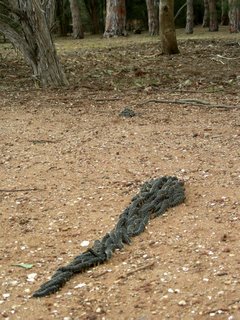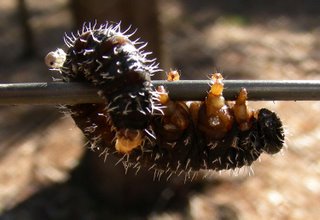 Now, not everybody goes gaga over a gang of sawfly larvae but I like them. They're odd little things, packed together into a mass, making their slow and determined way from one tree to another. This bunch were crossing the path at Serendip Sanctuary. I think most of them made it. When I passed the spot a couple of hours later only a couple of green smears indicated the death by boot of the unlucky few.
Now, not everybody goes gaga over a gang of sawfly larvae but I like them. They're odd little things, packed together into a mass, making their slow and determined way from one tree to another. This bunch were crossing the path at Serendip Sanctuary. I think most of them made it. When I passed the spot a couple of hours later only a couple of green smears indicated the death by boot of the unlucky few. Sawflies are closely related to ants, wasps and bees, although you might not be able to spot the resemblance from the larvae. Adult females insert their eggs into leaf tissues. Once hatched, the larvae feed on eucalypts. So voracious are they that they sometimes defoliate host trees. When ready to pupate, they burrow into soil at the base of the tree trunk.
Sawflies are closely related to ants, wasps and bees, although you might not be able to spot the resemblance from the larvae. Adult females insert their eggs into leaf tissues. Once hatched, the larvae feed on eucalypts. So voracious are they that they sometimes defoliate host trees. When ready to pupate, they burrow into soil at the base of the tree trunk.These sawflies are a species of Perga. They are known as spitfires because they regurgitate a glob of eucalyptus oil when annoyed. Very neat. Their food serves double duty as a source of nutrition and a weapon.
 Of course, that will only get you so far. There's always something that will circumvent the best defences.
Of course, that will only get you so far. There's always something that will circumvent the best defences. I noticed this lone larva on a fence wire. It seemed like a very strange place for a spitfire to be. When I looked more closely, I saw something on its back. I'm not certain but I suspect it's a parasitoid on its way out.
 Parasitoids are animals that spend part of their lives inside (or occasionally on the surface) of another animal—the host. Unlike parasites, which don't deliberately kill their host, parasitoids will do so much damage that the host invariably dies. Many wasps are parasitoids. They lay their eggs inside a host insect, providing their larvae with a constant supply of fresh food. When the larvae are ready to emerge, they force their way out, leaving behind little more than the hollowed out exoskeleton of the host.
Parasitoids are animals that spend part of their lives inside (or occasionally on the surface) of another animal—the host. Unlike parasites, which don't deliberately kill their host, parasitoids will do so much damage that the host invariably dies. Many wasps are parasitoids. They lay their eggs inside a host insect, providing their larvae with a constant supply of fresh food. When the larvae are ready to emerge, they force their way out, leaving behind little more than the hollowed out exoskeleton of the host. But wait! There's more. Some species of wasps are hyperparasitoids, which lay their eggs inside the eggs of other parasitoids. There are even hyperhyperparasitoids ... Russian dolls of gruesomeness. You never know what you're going to uncover next.
[That it's a parasitoid is my best guess. If anybody's got a better idea of what's happening, please let me know.]